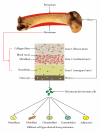Periosteum: a highly underrated tool in dentistry
- PMID: 21961003
- PMCID: PMC3179889
- DOI: 10.1155/2012/717816
Periosteum: a highly underrated tool in dentistry
Abstract
The ultimate goal of any dental treatment is the regeneration of lost tissues and alveolar bone. Under the appropriate culture conditions, periosteal cells secrete extracellular matrix and form a membranous structure. The periosteum can be easily harvested from the patient's own oral cavity, where the resulting donor site wound is invisible. Owing to the above reasons, the periosteum offers a rich cell source for bone tissue engineering; hence, the regenerative potential of periosteum is immense. Although the use of periosteum as a regenerative tool has been extensive in general medical field, the regenerative potential of periosteum is highly underestimated in dentistry; therefore, the present paper reviews the current literature related to the regenerative potential of periosteum and gives an insight to the future use of periosteum in dentistry.
Figures



Similar articles
-
Anatomy and histophysiology of the periosteum: quantification of the periosteal blood supply to the adjacent bone with 85Sr and gamma spectrometry.J Oral Implantol. 1995;21(3):214-9. J Oral Implantol. 1995. PMID: 8699515
-
Periosteum derived stem cells for regenerative medicine proposals: Boosting current knowledge.World J Stem Cells. 2014 Jul 26;6(3):266-77. doi: 10.4252/wjsc.v6.i3.266. World J Stem Cells. 2014. PMID: 25126377 Free PMC article. Review.
-
Translating Periosteum's Regenerative Power: Insights From Quantitative Analysis of Tissue Genesis With a Periosteum Substitute Implant.Stem Cells Transl Med. 2016 Dec;5(12):1739-1749. doi: 10.5966/sctm.2016-0004. Epub 2016 Jul 27. Stem Cells Transl Med. 2016. PMID: 27465072 Free PMC article.
-
A novel approach to regenerating periodontal tissue by grafting autologous cultured periosteum.Tissue Eng. 2006 May;12(5):1227-335. doi: 10.1089/ten.2006.12.1227. Tissue Eng. 2006. PMID: 16771636
-
Current insights on the regenerative potential of the periosteum: molecular, cellular, and endogenous engineering approaches.J Orthop Res. 2012 Dec;30(12):1869-78. doi: 10.1002/jor.22181. Epub 2012 Jul 9. J Orthop Res. 2012. PMID: 22778049 Free PMC article. Review.
Cited by
-
Periosteal pedicle graft for the treatment of gingival recession defects current status and future prospects: What the evidence suggests?J Indian Soc Periodontol. 2016 Mar-Apr;20(2):220-1. doi: 10.4103/0972-124X.170850. J Indian Soc Periodontol. 2016. PMID: 27143840 Free PMC article.
-
Periosteum for Root Coverage in an Isolated Gingival Recession as an Autogenous Graft: A Case Report.Cureus. 2024 May 13;16(5):e60207. doi: 10.7759/cureus.60207. eCollection 2024 May. Cureus. 2024. PMID: 38868280 Free PMC article.
-
Intraoral Bone Regeneration Using Stem Cells-What a Clinician Needs to Know: Based on a 15-Year MEDLINE Search.Front Dent. 2021 Nov 14;18:40. doi: 10.18502/fid.v18i40.7774. eCollection 2021. Front Dent. 2021. PMID: 35965732 Free PMC article. Review.
-
Periosteal pedicle graft with coronally advanced flap and its comparison with modified coronally advanced flap in the treatment of multiple adjacent gingival recessions-a randomized clinical trial.J Oral Biol Craniofac Res. 2021 Apr-Jun;11(2):99-106. doi: 10.1016/j.jobcr.2020.12.003. Epub 2021 Jan 6. J Oral Biol Craniofac Res. 2021. PMID: 33532194 Free PMC article.
-
Osteogenic and Chondrogenic Potential of Periosteum-Derived Mesenchymal Stromal Cells: Do They Hold the Key to the Future?Pharmaceuticals (Basel). 2021 Nov 8;14(11):1133. doi: 10.3390/ph14111133. Pharmaceuticals (Basel). 2021. PMID: 34832915 Free PMC article. Review.
References
-
- Finley JM, Acland RD, Wood MB. Revascularized periosteal grafts. A new method to produce functional new bone without bone grafting. Plastic and Reconstructive Surgery. 1978;61(1):1–6. - PubMed
-
- Reynders P, Becker J, Broos P. The osteogenic potential of free periosteal autografts in tibial fractures with severe soft tissue damage: an experimental study. Acta Orthopaedica Belgica. 1998;64(2):184–192. - PubMed
-
- Reynders P, Becker J, Broos P. Osteogenic ability of freeperiosteal autografts in tibial fracture with severe soft tissue damage. Journal Of Orthopaedic Trauma. 1999;13:121–128. - PubMed
-
- Provenza DV, Seibel W. Basic Tissues, Oral Histology Inheritance and Development. 2nd edition. Lea and Feibger; 1986.
-
- Orban BJ, Bhaskar SN. Orbans Oral Histology and Embryology. 11th edition 2002.
LinkOut - more resources
Full Text Sources

